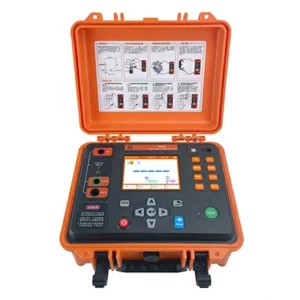How does the conductivity measurement relate to moisture content in insulation resistance tester?
Conductivity measurement and moisture content in insulation resistance testing are related in the context of electrical insulation materials. Here’s how they are connected:
- Moisture as a Conductor: Moisture is a significant factor affecting the conductivity of electrical insulation. Water, being a polar molecule, can ionize and increase the conductivity of the insulation material. When moisture is present in the insulation, it provides a conductive path for electrical current, reducing the insulation resistance.
- Insulation Resistance Testing: Insulation resistance testing, performed using an insulation resistance tester, measures the resistance to current flow through an insulating material. This test is crucial for assessing the integrity and reliability of electrical insulation, particularly in cables, wires, transformers, motors, and other electrical equipment.
- Moisture Detection: The presence of moisture in insulation can be detrimental to its performance and lifespan. Insulation resistance testing is often used as a diagnostic tool to detect moisture ingress or degradation in electrical insulation. A decrease in insulation resistance values indicates potential moisture-related issues, such as insulation breakdown, degradation, or the presence of water pathways.
- Correlation with Conductivity: In insulation resistance testing, a decrease in resistance values typically correlates with an increase in conductivity, insulation resistance tester which can be attributed to moisture presence. As moisture content rises, the insulation becomes more conductive, leading to lower insulation resistance readings during testing.
- Moisture Content Estimation: While insulation resistance testing provides valuable information about the condition of insulation, it does not directly measure moisture content. However, by monitoring changes in insulation resistance values over time or comparing them with baseline measurements, technicians can infer the presence and extent of moisture in the insulation.
- Preventive Maintenance: Regular insulation resistance testing, combined with other diagnostic techniques, helps identify potential moisture-related issues before they escalate into major failures or safety hazards. Early detection of moisture ingress allows for timely remediation measures, such as drying procedures, insulation replacement, or improved sealing to prevent further damage.
In summary, while insulation resistance testing does not directly measure moisture content, it serves as an effective tool for detecting moisture-related problems in electrical insulation by assessing changes in conductivity. By monitoring insulation resistance values, technicians can identify potential moisture ingress and take proactive steps to maintain the integrity and reliability of electrical systems.
